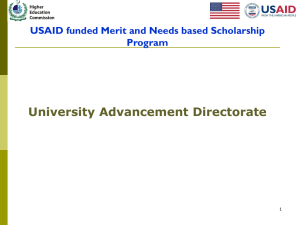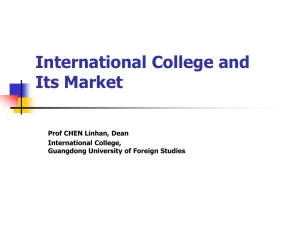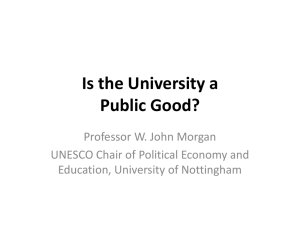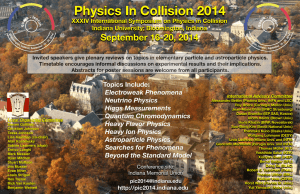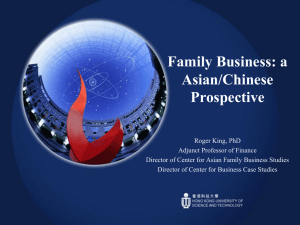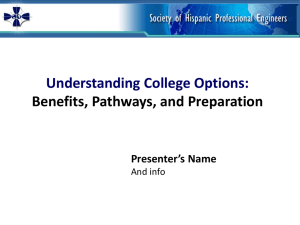1 - Global Academic Executive
advertisement
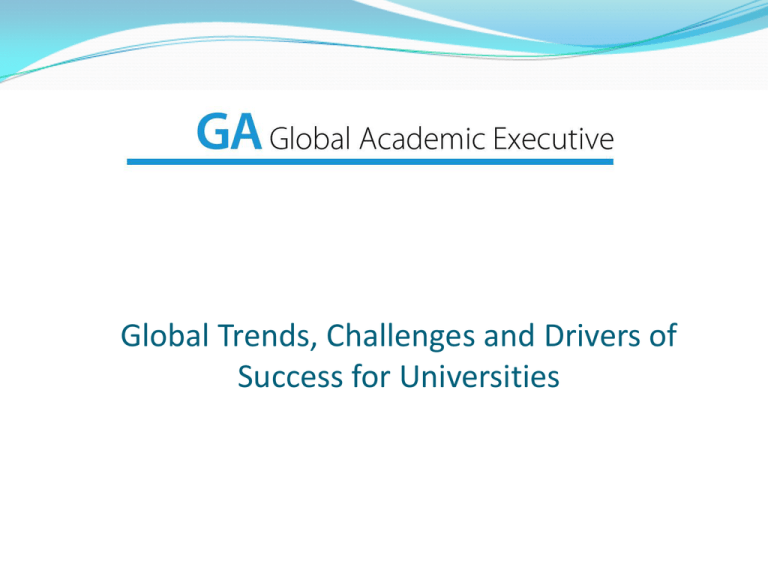
Global Trends, Challenges and Drivers of Success for Universities “The University is no longer a quiet place to teach and do scholarly work at a measured pace and contemplate the universe as in centuries past. It is a big, complex, demanding, competitive business requiring large-scale ongoing investment” Malcolm Skilbeck, The University Challenged1 1. Quotation sourced from “On the Edge: Securing a Sustainable Future for Higher Education”, OECD, 2004 Universities face a complex set of challenges Digital Technologies Integration with Industry Reporting requirements Market pressure to differentiate Pressure to Adopt Management Practices Fluctuating application levels Competition for Faculty, Students, Funding and Partners Global Mobility Model Innovation e.g. MOOCs Accountability to multiple stakeholders Pressure on public funding Broader and more diverse student body Universities are exposed to competition and market forces on a number of fronts Competitive Arena Example Segments Research Funding • Commonwealth • Industry • Other Donations • Alumni • Foundations/HNW individuals • Companies • Other Faculty Students • Leading researchers • Effective teachers • Effective leaders • Undergraduates • Research postgraduates • Professional postgraduates • International students • Distance students For each segment it competes in, a university needs to understand: • Intensity of competition • Nature and identity of: - Competitors - Substitutes - Potential entrants • Basis for competition • Relative power of suppliers/buyers North American universities occupy half of the top 30 places on the QS World University Rankings 2012 QS World University Rankings: Top 30 North America Europe Asia Australia US universities are winning an increasing share of Nobel prizes Percentage of Laureates by Institution Nationality 75% of Laureates since 1990 have been affiliated with US institutions Total prizes 33 24 32 38 30 55 59 77 75 75 52 Notes: Excludes Literature and Peace Laureates (only one peace Laureate and no Literature laureates were affiliated with an institution when their prize was awarded Source: Sutton Trust, “Nobel prizes, the Changing Pattern of Awards”, 2003; http://nobelprize.org; Success in competition for talent and for money determine a university’s relative status over time Competition for Talent “A university’s quality comes from the quality of its faculty and its students. Buildings and other tangible assets, as well as the professional and other staff, also constitute essential elements for quality, but all of these elements serve the academic needs of the faculty and students. Quality faculty at the level required to compete among the top American universities exists in limited supply. As a result, the national and international marketplace for research faculty is highly competitive. The university establishes its quality by recruiting, retaining, promoting and rewarding the best research faculty.” Competition for Money “The acquisition of revenue is another highly competitive markeplace for American universities. Money purchases the physical plant, facilities, quality staff, and competitive salaries that support and attract first-rate faculty. Money purchases the scholarships, fellowships, libraries and student facilities that attract the best students. Every dollar not required to support continuing operations is a dollar that the university can invest in improving research or student quality. The effectiveness of the university in acquiring these funds and investing them in research or student quality determines the relative success of the university within its competitive marketplaces.” John V. Lombardi, “Quality Engines: The Strategic Principles for Competitive Universities in the Twenty-First Century”, The Centre Reports, March 2001 There is a clear cycle of success in the world’s top universities Competitive salaries Research funding and facilities Research grants Contract research IP-related revenue Strong Research Performance HR Policy Strong Faculty Strong Reputation Financial Strength Donations, Commercial ventures, fees Donations Successful Alumni High Quality Students Strong Teaching Performance Scholarships Facilities and support (Endowment + Annual Giving + Operational Surplus) Less than 5% of US higher educational institutions conduct over 90% of the research US Higher Educational Institutions 2002-03 Highest Degree Offered 4168 % Private Doctorate 261 36% Masters 646 56% Baccalaureate 658 85% Other 4 Year Qualification 759 92% 2 Year Qualification 1844 40% • Exceptional diversity in terms of size (~500 to ~50,000 students), breadth of focus, private vs public ownership, research vs teaching focus, sectarian vs secular orientation • Highly concentrated research resources, with over 90% of the total federal scientific research funding controlled by just 150 universities Source: NCES Digest of Education Statistics, 2003; Lombardi, John V., Quality Engines: The Strategic Principles for Competitive Universities in the Twenty First Century; The Centre Reports, March 2001 Endowment funds at top US universities are much larger than at UK universities Endowment per Student Total Endowment 20031 (£ Billion) (£’000s) Top 5 UK Universities King's 0.1 6.7 Glasgow 0.1 6.5 Edinburgh 0.2 9.0 Oxford 2.0 119.0 Cambridge 2.0 120.0 Stanford Top 5 US Universities Princeton Texas Yale Harvard 4.8 358.0 5.2 813.0 5.4 109.0 6.6 593.0 10.7 550.0 Note: (1) Cambridge and Oxford include university and college endowment. University endowment alone for Cambridge was £660m and £470m for Oxford in 2002. Source: The Sutton Trust, ‘University Endowments – A UK / US Comparison’, May 2003 Higher ranking universities tend to have larger endowments Shanghai Score vs Endowment per Student Endowment / Student (US$ million) 3.5 R2 = 0.462 3.0 2.5 Annual giving also needs to be factored in – it is very significant for leading US public universities 2.0 1.5 1.0 0.5 0.0 0 Note: 20 40 60 80 Shanghai Rankings - Points Scored 100 (1) Shanghai Ranking data is 2004; Endowment data is 2003 Source: The Times Higher Education Supplement, Nov 2004; ‘Voluntary Support of Education’, Council for Aid to Education, New York 2003; Shanghai Ranking http://ed.sjtu.edu.cn; The Sutton Trust ‘University Endowments a UK/US comparison’ May 2003. Various factors contribute to US universities’ strong fundraising performance Factor Observations Cultural attitudes • Culture of ‘mass giving’ in the USA, with charitable donations amounting to 2% of GDP (0.6% in the UK) Income levels and wealth differentials • Wealthy individuals are a key source of donated funds: over half the total value of alumni donations comes from 1% of alumni The USA has by far the largest number of wealthy individuals, with over 2.3 million high net worth and 32,000 ultra-high net worth individuals in 2003 – By comparison, there were 0.1m high net worth and around 700 ultra high net worth individuals in Australia in 2003 • University environment • Intense student experience in leading US universities (living on campus, interacting outside faculty, etc.) fosters strong emotional connection to university University fundraising practices • Top US universities have very active alumni and fundraising programs, generating extremely high participation rates (e.g. 64% for Princeton) Areas of focus include active alumni programs to generate sense of community, high profile general appeals, and targeted programs to attract major donors Taxation of donations • • • USA: donors can claim back all charitable donations directly from income tax UK: complex tax treatment; donor and the beneficiary share the tax rebate Note: (1) High net worth individuals are those with more than US$1m in net financial assets; ultra high net worth are those with over US$30m in net assets Source: World Wealth Report 2004, Cap Gemini and Merrill Lynch; Source: The Sutton Trust, ‘University Endowments – A UK / US Comparison’, May 2003 Alumni, other individuals and foundations provided 75% of donations to US universities in 2002-03 Sources of Voluntary Support for US Higher Education 2002-03 (US$ billion) Total = US$23.9 billion Percent of total Growth over 5 years 28% +20% 19% +1% 6.6 28% +74% Corporations 4.3 18% +31% Other Organisations 1.9 8% -1% Alumni 6.6 Other Individuals 4.6 Foundations Source: The Chronicle of Higher Education, 2004 Universities have multiple stakeholders, making it harder to define a single objective function Stakeholder Relationship Key Needs Students • Customers • Improve future income • Build social / career network • Gain status Alumni • Donors • Ambassadors • Association with successful institution • Ongoing access to social network and new knowledge Staff • Producers of research and teaching outputs • Manage university • Competitive research infrastructure • Competitive remuneration Businesses and public sector organisations • Employers of graduates • Research / commercial partners • High quality graduates with relevant skills • Commercially valuable R&D Federal Government • Funds research and teaching • Sets educational policy • Contain costs • Contribute to social and economic goals Other stakeholders: state government, parents, professional associations, community Every university needs to decide: • In addressing stakeholders’ needs, what should we try to maximise, and where can we satisfice? • Can we assemble the resources to pursue all of these objectives, or do we need to narrow our focus? • Where should we focus? Which stakeholders / segments are key to our success? An organisation’s competitive position in its industry is defined by the type of advantage it pursues and the breadth of its market focus Type of Advantage Broad Low-Cost Differentiation Cost Leadership Differentiation Mass Market Segment cost leadership Segment differentiation Over-served or under-served segments Market Focus Narrow A superior competitive position requires superior capabilities; this position is only sustainable if they are based on hard-to-replicate resources Resources Hard-to-replicate assets and activity system Assets and activities that are difficult for other firms to acquire or imitate are the most secure basis for sustainable advantage Capabilities Leadership in one or more market-relevant capabilities Explicit trade-offs usually necessary to create industry leading capabilities Competitive Position Unique, sustainable cost or differentiation advantage in chosen markets Offerings Products and services with a unique price/value proposition attractive to target customers A cost or differentiation advantage allows a company to generate superior returns Example of Trade-Offs: Revenue diversification may improve financial performance and strengthen institutional autonomy, but it may also require trade-offs with other objectives Revenue Source Perceived trade-offs International students Diversion of resources from domestic students Full fee paying domestic students Potential lowering of standards Continuing education fees Distraction from core teaching activities Bequests and donations Withdrawal of other funding sources Industry funded research Reduced independence and knowledge sharing Research commercialisation Reduced knowledge sharing Consultancy fees Distraction from core teaching and research activities The strategy needs to be translated into a prioritised set of organisational requirements Key organisational capabilities required to support business strategy How important is this characteristic in key markets? Market A Minimise administration costs Maintain world-class expertise in key areas Coordinate development and delivery of outputs across divisions Support customised outputs for specific customers and customer segments Maintain flexibility to adapt to rapidly changing competitive environment Facilitate development of new businesses Enable external strategic and commercial links Market B Market C Priority An effective organisational strategy should align decision rights, structure and performance management with the business strategy Allocation of Decision Rights Systems Business Strategy Required Organisational Capabilities Organisational Structure Performance Management Policies Processes People “How, then, are American universities so successful? Primarily, I would say, by maintaining this ferment, this clash of perspective, and this reliance on the authority of ideas. And we compete vigorously: for the best students, the best young faculty, and the allegiance of donors. Without this competitive environment, the tendency towards self-replication, towards inbred comfort, could become dominant. Finally, governing a university is a subtle thing. As we’ve seen too often abroad, and increasingly in public higher education here, efforts by larger government bodies to manage aspects of public life are doomed to fail. Creativity is repelled rather than attracted, inspiration is dulled – and disappointment is the result. At the same time, we have seen that the team cannot be managed by its players. Too often, universities have been managed as kibbutzim, with academic leaders elected by faculty, students and staff, thus undercutting mandates to impose high standards and the creation of leadership horizons sufficient for true long-term innovation Success depends on the middle ground. Leadership that is strong, not bureaucratic; leadership that recognizes the best ideas come from creative scholars, not managers; and leadership that knows if everything is a priority, nothing is a priority. For priorities, like energy, like capital, must be conserved.” Lawrence H. Summers, President, Harvard University1 1. Quotation sourced from Harvard Magazine, November – December 2004 BCG / WFPMA - Global Survey 2012 13/04/2015 21 BCG Report – Importance of HR Capabilities 22 13/04/2015 Economic Impact of HR Capabilities 13/04/2015 23 BCG Conclusions 13/04/2015 24 Strategic Workforce Planning 13/04/2015 25 Recruitment Media 13/04/2015 26 Talent and Leadership Management 13/04/2015 27 Appendix 13/04/2015 28 US universities spent US$36 billion on research in 2003, 60% of which was funded by the Federal Government Sources of Funding for Research and Development by US Universities in 2003 Other 7.4% Total Expenditure: US$36.3 billion Institution 19.6% Industry 6.0% 6.9% State and Local Government Note: 60.1% Federal Government Total expenditure on research & development by Australian institutions in 2002 was A$3.4 billion (approx. US$2.4 billion) US Federal Government departmental breakdown: Health & Human Services = $13.4bn;National Science Foundation = $2.8bn; Defense = $2.1bn; NASA = $1.1bn; Agriculture = $0.6bn; Energy = $0.7bn Source: The Chronicle of Higher Education, 2004 Unique resources and capabilities are protected by barriers to imitation • A competitive advantage is sustainable when it persists, despite efforts by competitors or potential entrants to imitate it – – • The organisation must possess unique resources and capabilities It must be difficult for other firms to acquire or develop these resources and capabilities This requires resources and capabilities that are protected by barriers to imitation Potential Entrants Barriers to Entry Competitors Barriers to Imitation Organisation Industry A unique value proposition can be visualised as a distinctive value curve Eating facilities Average One Star Hotel Architectural aesthetic Lounges Average Two Star Hotel Room size Reception hours Room amenities Bed quality Hygiene Formule 1 Room quietness Price High Low Relative Level Source: “Value Innovation: The Strategic Logic of High Growth”, W. Chan Kim and Renee Mauborgne, Harvard Business Review, Jul-Aug 2004 Barriers to imitation include early-mover advantages, trade-offs and other factors Early-Mover Advantages Trade-Offs Other Factors Learning curve Network externalities e.g. strong alumni network Firm or brand reputation e.g. customer uncertainty when buying experience products Buyer switching costs e.g. customer investment in learning to use software Incompatible product attributes or design features e.g. research vs teaching only focus Inconsistencies in brand image or reputation e.g. traditional vs innovative image Limits on internal coordination, measurement and motivation e.g. “culture clash” Economies of scale Legal restrictions e.g. patents, trademarks, copyrights, licenses Superior access to inputs e.g. ownership or long-term contracts Superior access to customers e.g. location, exclusive distribution channels Intangible barriers e.g. causal ambiguity An effective strategy requires a unique value proposition based on distinctive, inimitable capabilities – most “strategies” fail this test What Is a Strategy? The right goal and A unique value proposition and Clear trade-offs and Tailored activities fitting together in an integrated system and Consistent improvement, but with continuity of the strategic position Source: Michael Porter, Competitive Strategy 2002 What Is Not a Strategy? Best practice or A vision or Learning / flexibility / agility or Innovation or Restructuring or Mergers/alliances or CRM or The Internet US universities occupy 17 of the top 20 places in the Shanghai Jiao Tong University Rankings 2006 World University Rankings, Shanghai Jiao Tong University: Top 20 1 Harvard Univ 2 Univ Cambridge 3 Stanford Univ 4 Univ California - Berkeley 5 Massachusetts Inst Tech (MIT) 6 California Inst Tech 7 Columbia Univ 8 Princeton Univ 9 Univ Chicago 10 Univ Oxford 11 Yale Univ 12 Cornell Univ 13 Univ California - San Diego 14 Univ California - Los Angeles 15 Univ Pennsylvania 16 Univ Wisconsin - Madison 17 Univ Washington - Seattle 18 Univ California - San Francisco 19 Tokyo Univ 20 Johns Hopkins Univ 100.0 72.6 72.5 72.1 69.7 US 66.0 61.8 Europe 58.6 Asia 58.6 57.6 55.9 54.1 50.5 50.4 50.1 48.8 Australian Universities in Top 100 48.5 Rank University Score 47.7 54 Australian National University 30.8 46.7 78 University of Melbourne 26.4 46.6 Source: Academic Ranking of World Universities 2006, Institute of Higher Education Shanghai Jiao Tong University US universities are slightly less dominant on the more broadly-based Times Higher Rankings 2005 World University Rankings, The Times Higher: Top 20 North America Europe Asia Australia Other Australian Universities in Top 50 Source: The Times Higher Education Supplemen, October 28 2005 Rank University 23 33 38= 47 Australian National University Monash University Sydney University Queensland University Score 52.9 46.5 42.6 38.5
